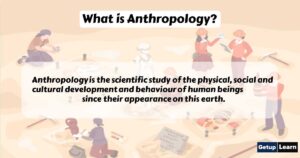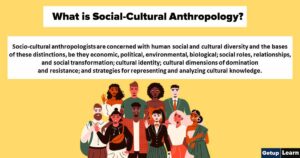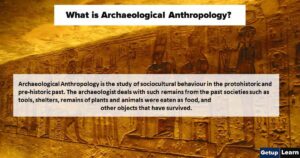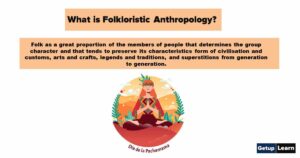Table of Contents
What is Biological Anthropology?
Biological Anthropology starts with the study of the origin and evolution of humans and analyses their diversity. It also examines the biosocial adaptation of different human populations living in different geographical and ecological settings.
The name biological anthropology came into vogue when scientists started studying humans based on evidence that was not just limited to bones. For example the study of human genetics, the study of primates and their relationship to the environment, etc.

Table of Contents
In its comprehension of variability, adaptation, and evolution, it also identifies itself as social science, as the study of the human species is incomplete without its cultural context. So physical anthropology trains one to learn the basic principles of evolutionary biology and human genetics; the similarities and differences between humans, mammals.
Primate species; the vital issues of hominid evolution including the analysis of fossils and molecular evidence to understand the origin of modem humans; the role of genetic, ecological, and socio-cultural components on biological differences in living human populations and biocultural overview on human growth and development.
Fields of Biological Anthropology
Today the study of biological anthropology has become immensely diverse. It has come a long way from the study of primates with the help of fossils and skull findings.
However, primate classification on the basis of fossil evidence still remains vital to know the hominid tree, other concerns like the evolution of the human species, extinction and mutation of species, differences and similarities occurring in the process, etc.
The biological bases of human behaviour and human biological variability are also other major concerns of study. Methods of study used by biological anthropologists are highly scientific and allow cross comparative analysis.
Current concerns of biological anthropology are briefly discussed to give a basic understanding to the learners:
- Paleoanthropology
- Paleoprimatology
- Osteology
- Human Genetics
- Population Genetics
- Molecular Anthropology
- Human Variation
- Human Growth and Development
- Human Ecology
- Forensic Anthropology
- Demography
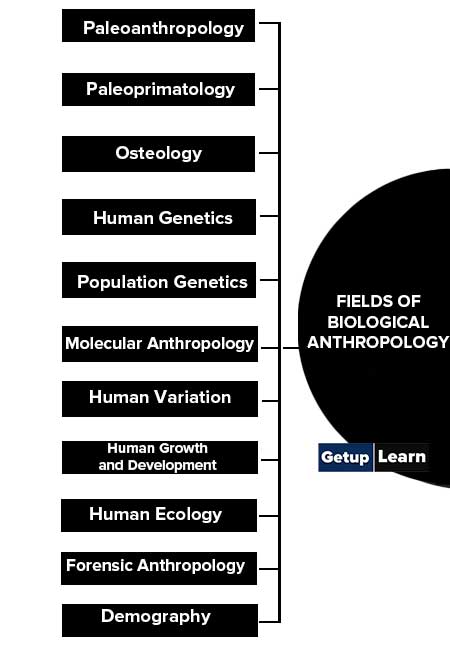
Paleoanthropology
This field is the most fundamental and among the oldest fields in physical anthropology. It is a study that combines palaeontology and physical anthropology to learn about humans and their evolution from fossil hominid evidence, artefacts and also on the basis of geological and burial site evidence.
Through such collection, repairing and reconstruction are done to provide an anatomical description, show variation and the specimen position in hominid evolutionary development. Wherever necessary, statistical methods are also made use of.
Paleoprimatology
Besides taking help from past evidence, physical anthropologists also seek help from non-human primates to make a com para ti ve study of their behaviour and perceptive capacity with human ancestors, to comprehend humans’ natural history, to know their position as mammals, etc.
Osteology
The name is a scientific connotation of what the study of bones is. It is that part of physical anthropology that helps in the identification of human remnants in terms of age, sex, growth, development, and death by studying the bone structure, skeletal features, morphology, etc.
Human Genetics
The field of human genetics is of use to physical anthropology as together they primarily study hereditary transmission in humans. In fact, physical anthropology began to be called biological anthropology with the introduction of genetics into its framework of study.
As genes are the most common factor to provide for most inherited human traits, hence the study of human genetics is important in anthropology. As anthropology fundamentally concerns itself with humans, human genetics serves enough help to understand human diseases and also provide solutions for such.
Population Genetics
This field, though hard-core biology oriented domain, is particularly important to physical anthropology as it concerns itself with the processes of evolution, i.e., natural selection, genetic drift, gene flow and mutation.
It takes into consideration components of populations to study the frequency, distribution and change in allele which in turn helps in understanding how new species are developed and their adaptation.
Molecular Anthropology
This arena of physical anthropology deals with the use of molecular analysis, to comprehend the connectivity between earlier and contemporary humans. This is done with the use of a DNA sequence. It also includes the comparative study of all existing populations.
Human Variation
The study of human variation is a prominent facet in physical anthropology where how human evolution has occurred throughout history throughout geographic locations is learned. The study of “race” which dominated the development of the di sci pli ne is what human variation is all about, giving it a more ethical representation.
The variability observed are ones that have permanency, like mental and physical differences, which can be measured.
Human Growth and Development
This field is an important subject for physical anthropologists to investigate. It probes to find out and detail the rate at which a human grows, points out specific events in the process of development and also inquires how environment, nutrition and heredity affect the physical body.
Human Ecology
The relationship of humans with their physical, natural, and created environments and its study is another part of physical anthropology which is immensely needed as human ecology exhibits the implications it has on human growth, behaviour and sustainability. As human ecology links itself with the social life of humans, it is hence studied in social anthropology too.
Forensic Anthropology
This is a popular applied portion of physical anthropology where the technique???? developed in it are used in the identification of human remains in a legal scenario. Forensic anthropologists help to imply the sex, height, age, and other features of a dead person from the remains of the body.
Demography
To understand the size, structure and distribution of human populations, physical anthropology makes use of statistical methods which fa!] under the fold of demography. It also looks into changes in time and space in population on the basis of birth, migration and death.
So from the above deliberation, we see that physical or biological anthropology has come a long way in its pursuit of cognizance concerning the development and evolution of human beings.
Today its processes have widened hugely and have opened avenues for individuals by providing opportunities in academics, research institutes, health organizations, museums, primate centres, etc. Physical anthropology contributes to the understanding of humans in all its aspects.
History of Biological Anthropology
We would now discuss how this branch took shape and became what it is today. Physical anthropology grew gradually and established itself as a human science with the amalgamation of various sciences by venturing into new areas and with the application of already existing concepts to new data.
Edward Tyson (1650-1708), one of the prominent founders of primatology, conducted the first systematic research in 1699 on the anatomical differences between humans and apes. This facilitated the interest to know the origin and nature of the human race which consequently solicited the beginning of physical anthropology. This can be dated back to the eighteenth century when the study of the race took a scientific turn.
The German physician Johann Friedrich Blumenbach ( 1752-1840) is considered to be the first prominent physical anthropologist who invented the study of craniology through which he made 5 major classifications of the human races (Caucasian, Mongolian, Malayan, Ethiopian, and American) on the basis of skull findings. He was a student of Carl Linneaus, who was an exponent of zoology and included humans in the classification of primates.
Around the same time, anthropological traditions started to gain ground with French anthropologist and physician, Paul Broca (1824-1880) becoming the founder of the Anthropological Society in Paris in 1859, the Revue d’ Anthropologie in 1872, and the School of Anthropology in Paris in 187 6. He made huge advances in the study of cranial anthropometry, thus paving the way for more development in the study of physical anthropology.
In Germany Rudolf Virchow (1821-1902), one of the founders of social medicine opined on how human beings changed gradually and the role of the environment and diseases on it. In the philosophical arena at the beginning of the 20th century, with anthropometry becoming more sophisticated and scientific, thanks to the efforts of Karl Pearson (1857-1936), the Americans also started gaining ground in the creation of physical anthropology as a distinct discipline.
Ales Hrdlicka (1860-1943) is synonymous with the development of physical anthropology at the Smithsonian Institute in America. Earnest A. Hooton (1887- 1954) introduced the subject at Harvard University. Hrdlicka was responsible for establishing the American Journal of Physical Anthropology in 1918. He also encouraged the creation of the American Association of Physical Anthropologists in 1930.
Earnest Hooton, on his part, trained many noteworthy physical anthropologists like Harry L. Shapiro and Carleton S. Coon. During the same period, Germany produced anthropologists to reckon with, like Eugen Fischer, Fritz Lenz and Erwin Baur. Though there was a continuous intellectual conflict between the Americans and the Germans, both contributed immensely to the development of physical anthropology.
In the 1950s and 1960s, physical anthropology took a different turn where fieldwork tradition was reintroduced. It was Sherwood Washburn, a student of Hooton who spearheaded this trend by giving weightage to the understanding of primatology and paleoanthropology rather than just concentrating on human races.
This paved the way for contemporary anthropology which included newer fields like human genetics, paleopathology, etc. Scholars like L.S. B. Leakey, Jane Goodall, Dian Fossey, etc. contributed to the study of naturalistic science in anthropology.
YOU MIGHT ALSO LIKE
- What is Anthropology?
- Branches of Anthropology
- What is Social Anthropology?
- Scope of Social Anthropology
- Nature of Social Anthropology
- What is Social Cultural Anthropology?
- Theories of Sociocultural Anthropology
- What are Archaeological Sites?
- Types of Archaeological Sites
- What is Linguistic Anthropology?
- What is Marriage?
- Types of Marriage
- What is Family?
- Types of Family in Sociology
- Functions of the Family
- Folk literature
- What is Biological Anthropology?
- Biological Anthropology Fields of Study
- What is Social Anthropology?
- Definition of Social Anthropology
- Scope of Social Anthropology
- Nature of Social Anthropology
- What is archaeology?
- What is Archaeological Anthropology?
- Process of Archaeology
- Types of Archaeology Sites
- Linguistics Language
- Linguistic Culture
- Types of Marriages
- What is Kinship?
- Types of Kinship Groups
- What is Folkloristic Anthropology?
What does a biological anthropologist do?
The name biological anthropology came into vogue when scientists started studying humans based on evidence that was not just limited to bones. For example the study of human genetics, the study of primates and their relationship to the environment, etc.
What are the types of biological anthropology?
These are the types of biological anthropology Paleoanthropology, Paleoprimatology, Osteology, Human Genetics, Population Genetics, Molecular Anthropology, Human Variation, Human Growth and Development, Human Ecology, Forensic Anthropology, Demography etc.
When did biological anthropology begin?
Edward Tyson (1650-1708), one of the prominent founders of primatology, conducted the first systematic research in 1699 on the anatomical differences between humans and apes. This facilitated the interest to know the origin and nature of human race which consequently solicited the beginning of physical anthropology. This can be dated back to the eighteenth century when the study of race took a scientific turn.





